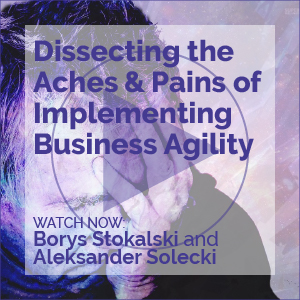Radical Management and Strategy: Part VII -- Who Owns What?
Steve Andriole
Radical Management and Strategy series: Part I: What We're Doing with the New Stuff
Overmanaged and Underled
Jeff Scott
Overmanaged and Underled
Jeff Scott
Service-Oriented Architecture: Part IV -- Development and Ownership
Tom Welsh
Service-Oriented Architecture series: Part I -- Awareness and Plans
Sarbanes-Oxley: More than Meets the Eye
Claudia Imhoff
Cutter IT Journal: The Evolution of Agile Project Management: Part II
Jim Highsmith
It's a Big Tent Agile project management can cover a wide range of projects and organizational cultures. Given the right structuring, APM can coexist with other project management frameworks — even the PMI's PMBOK Guide® or the SEI's CMMI®.
The Evolution of Agile Project Management: Part II -- Opening Statement
Jim Highsmith
Opening Statement by Jim Highsmith Agile PM and the PMBOK Guide® by Donna Fitzgerald The Four Roles of Agile Management by David J. Anderson
Agile PM and the PMBOK Guide®
Donna Fitzgerald
Opening Statement by Jim Highsmith Agile PM and the PMBOK Guide® by Donna Fitzgerald The Four Roles of Agile Management by David J. Anderson
The Four Roles of Agile Management
David Anderson
Opening Statement by Jim Highsmith Agile PM and the PMBOK Guide® by Donna Fitzgerald The Four Roles of Agile Management by David J. Anderson
How to Succeed on Today's Extreme Projects
Doug Decarlo
Opening Statement by Jim Highsmith Agile PM and the PMBOK Guide® by Donna Fitzgerald The Four Roles of Agile Management by David J. Anderson
Beyond the Hype of a New Approach
Jim Brosseau
Opening Statement by Jim Highsmith Agile PM and the PMBOK Guide® by Donna Fitzgerald The Four Roles of Agile Management by David J. Anderson
Adding Stakeholder Metrics to Agile Projects
Tom Gilb
Opening Statement by Jim Highsmith Agile PM and the PMBOK Guide® by Donna Fitzgerald The Four Roles of Agile Management by David J. Anderson
Let's Follow the Lead of Agriculture and Manufacturing
Paul Bassett
In the US, agriculture employed 63% of the workforce in 1840 compared with just 2% today. In 1943, the number of US blue-collar employees reached its peak, accounting for at least 40% of the workforce. That number has steadily declined since then to about 8%, and before the end of the century may well fall to the same level as that of agriculture [3].









